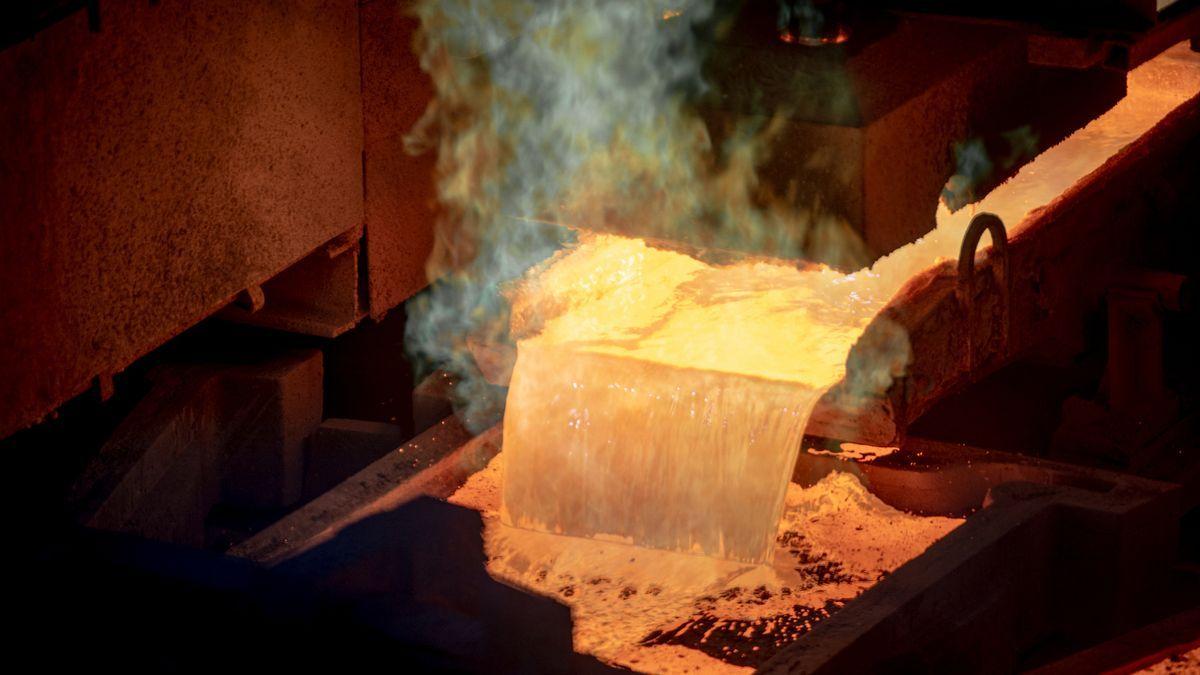Physical Buyers Gain Upper Hand in Copper Market as Funds Retreat
3 Sources
3 Sources
[1]
Physical buyers win battle for copper market as funds retreat
Investors fleeing the copper market are likely to be sidelined for many months, leaving the field clear for physical players who expect demand in top consumer China and elsewhere to deteriorate over coming months and weigh on prices. A fund buying frenzy, based on an expected shortage of copper relative to demand, sparked a rally on the London Metal Exchange (LME) earlier this year, which quickened as momentum traders entered the fray to lift prices to a record high above $11,100 a metric ton in May. At the same time, commodity traders were buying on the LME to deliver against their commitments to sell copper on COMEX, part of CME Group. However, copper has dropped nearly 20% since as persistently weak manufacturing activity led the physical market to reassert control, with consumers putting purchases on hold and producers and traders delivering surplus metal to LME-registered warehouses. "Updates to demand and refined production have pushed the market to a surplus sooner than expected," said Macquarie analyst Alice Fox, who expects copper surpluses of 265,000 metric tons this year, 305,000 tons in 2025 and 436,000 in 2026. Fox said prices may recover in the fourth quarter if exchange stocks are drawn down. "However, absent faster global growth boosting demand, the more sizeable surpluses in 2025 and 2026 mean this rally is likely to be short-lived," Fox said, adding that prices could fall back towards $8,000. BURNT FINGERS LME copper hit 4-1/2 month lows of $8,714 a ton in early August as U.S. recession fears and concern the Federal Reserve has kept interest rates too high exacerbated negative sentiment from soaring inventories and lacklustre demand. China consumes more than half of global refined copper supplies, estimated at around 26 million tons this year. But much of the copper used in China is for wiring in household goods which are then exported. A housing market slump and China's stagnant manufacturing sector highlight the headwinds copper demand faces. "If you strip out exports, domestic demand in China looks to be anaemic. There's no copper shortage," said BNP Paribas analyst David Wilson, who expects a surplus of between 150,000 and 200,000 tons this year. "Product fabricators have destocked. If you are a manufacturer and unsure about the outlook for demand and exports, you are not going to restock aggressively." Data from the International Copper Study Group (ICSG) showed a copper market surplus of 416,000 tons between January and May, laying bare the idea of large deficits this year. Copper inventories in warehouses registered with the LME, a market of last resort, have risen to five-year highs above 300,000 tons, up around 200% since mid-May. Most of the metal was delivered to LME warehouses in Korea and Taiwan. It came from Chinese producers unable to sell their wares to the domestic market and aiming to take advantage of LME prices above those on the Shanghai Futures Exchange. Copper stocks in the South Korean cities of Busan and Gwangyang and Taiwan's Kaohsiung totalling 239,100 tons now comprise 78% of total copper stocks in the LME system compared with 31,925 tons and 31% on May 16. The threat of a prolonged strike at BHP's Escondida copper mine in Chile, which produced nearly 5% of the world's copper in 2023, raised concerns last week about tighter supplies but a settlement on Sunday dispelled the fears. Over the longer term however, deficits are predicted as structural changes to copper consumption from new technologies linked to AI and the energy transition accelerate. "We still see copper as the backbone for decarbonisation," said Glencore CEO Gary Nagle at a recent briefing. "Spending on AI data centres, renewable infrastructure is very copper hungry, very copper intensive." (Reporting by Pratima Desai; editing by Veronica Brown and Kirsten Donovan)
[2]
Physical buyers win battle for copper market as funds retreat
LONDON, Aug 19 (Reuters) - Investors fleeing the copper market are likely to be sidelined for many months, leaving the field clear for physical players who expect demand in top consumer China and elsewhere to deteriorate over coming months and weigh on prices. A fund buying frenzy, based on an expected shortage of copper relative to demand, sparked a rally on the London Metal Exchange (LME) earlier this year, which quickened as momentum traders entered the fray to lift prices to a record high above $11,100 a metric ton in May. At the same time, commodity traders were buying on the LME to deliver against their commitments to sell copper on COMEX, part of CME Group. However, copper has dropped nearly 20% since as persistently weak manufacturing activity led the physical market to reassert control, with consumers putting purchases on hold and producers and traders delivering surplus metal to LME-registered warehouses. "Updates to demand and refined production have pushed the market to a surplus sooner than expected," said Macquarie analyst Alice Fox, who expects copper surpluses of 265,000 metric tons this year, 305,000 tons in 2025 and 436,000 in 2026. Fox said prices may recover in the fourth quarter if exchange stocks are drawn down. "However, absent faster global growth boosting demand, the more sizeable surpluses in 2025 and 2026 mean this rally is likely to be short-lived," Fox said, adding that prices could fall back towards $8,000. LME copper hit 4-1/2 month lows of $8,714 a ton in early August as U.S. recession fears and concern the Federal Reserve has kept interest rates too high exacerbated negative sentiment from soaring inventories and lacklustre demand. China consumes more than half of global refined copper supplies, estimated at around 26 million tons this year. But much of the copper used in China is for wiring in household goods which are then exported. A housing market slump and China's stagnant manufacturing sector highlight the headwinds copper demand faces. "If you strip out exports, domestic demand in China looks to be anaemic. There's no copper shortage," said BNP Paribas analyst David Wilson, who expects a surplus of between 150,000 and 200,000 tons this year. "Product fabricators have destocked. If you are a manufacturer and unsure about the outlook for demand and exports, you are not going to restock aggressively." Data from the International Copper Study Group (ICSG) showed a copper market surplus of 416,000 tons between January and May, laying bare the idea of large deficits this year. Copper inventories in warehouses registered with the LME, a market of last resort, have risen to five-year highs above 300,000 tons, up around 200% since mid-May. Most of the metal was delivered to LME warehouses in Korea and Taiwan. It came from Chinese producers unable to sell their wares to the domestic market and aiming to take advantage of LME prices above those on the Shanghai Futures Exchange. Copper stocks in the South Korean cities of Busan and Gwangyang and Taiwan's Kaohsiung totalling 239,100 tons now comprise 78% of total copper stocks in the LME system compared with 31,925 tons and 31% on May 16. The threat of a prolonged strike at BHP's Escondida copper mine in Chile, which produced nearly 5% of the world's copper in 2023, raised concerns last week about tighter supplies but a settlement on Sunday dispelled the fears. Over the longer term however, deficits are predicted as structural changes to copper consumption from new technologies linked to AI and the energy transition accelerate. "We still see copper as the backbone for decarbonisation," said Glencore CEO Gary Nagle at a recent briefing. "Spending on AI data centres, renewable infrastructure is very copper hungry, very copper intensive." (Reporting by Pratima Desai; editing by Veronica Brown and Kirsten Donovan)
[3]
Physical buyers win battle for copper market as funds retreat
A view of the Codelco El Teniente copper mine, the world's largest underground copper mine, near Rancagua, Chile. -- Reuters file Investors fleeing the copper market are likely to be sidelined for many months, leaving the field clear for physical players who expect demand in top consumer China and elsewhere to deteriorate over coming months and weigh on prices. A fund buying frenzy, based on an expected shortage of copper relative to demand, sparked a rally on the London Metal Exchange (LME) earlier this year, which quickened as momentum traders entered the fray to lift prices to a record high above $11,100 a metric ton in May. At the same time, commodity traders were buying on the LME to deliver against their commitments to sell copper on COMEX, part of CME Group. However, copper has dropped nearly 20 per cent since as persistently weak manufacturing activity led the physical market to reassert control, with consumers putting purchases on hold and producers and traders delivering surplus metal to LME-registered warehouses. "Updates to demand and refined production have pushed the market to a surplus sooner than expected," said Macquarie analyst Alice Fox, who expects copper surpluses of 265,000 metric tonnes this year, 305,000 tonnes in 2025 and 436,000 in 2026. Fox said prices may recover in the fourth quarter if exchange stocks are drawn down. "However, absent faster global growth boosting demand, the more sizeable surpluses in 2025 and 2026 mean this rally is likely to be short-lived," Fox said, adding that prices could fall back towards $8,000. Burnt fingers LME copper hit four-and-a-half month lows of $8,714 a tonne in early August as US recession fears and concern the Federal Reserve has kept interest rates too high exacerbated negative sentiment from soaring inventories and lacklustre demand. China consumes more than half of global refined copper supplies, estimated at around 26 million tonnes this year. But much of the copper used in China is for wiring in household goods which are then exported. A housing market slump and China's stagnant manufacturing sector highlight the headwinds copper demand faces. "If you strip out exports, domestic demand in China looks to be anaemic. There's no copper shortage," said BNP Paribas analyst David Wilson, who expects a surplus of between 150,000 and 200,000 tonnes this year. "We still see copper as the backbone for decarbonisation," said Glencore CEO Gary Nagle at a recent briefing. "Spending on AI data centres, renewable infrastructure is very copper hungry, very copper intensive."
Share
Share
Copy Link
The copper market is experiencing a shift as physical buyers assert dominance over financial investors. This change is driven by China's economic recovery and supply concerns, leading to increased demand and higher premiums for copper cathodes.

Shift in Copper Market Dynamics
The global copper market is witnessing a significant transformation as physical buyers gain the upper hand over financial investors. This shift is primarily driven by China's economic recovery and growing concerns about supply constraints
1
. The change in market dynamics has led to increased demand and higher premiums for copper cathodes, reflecting the growing influence of real-world consumers in the market.China's Economic Recovery Fuels Demand
China, the world's largest copper consumer, has been showing signs of economic recovery, particularly in its manufacturing and construction sectors. This resurgence has resulted in a surge in demand for copper, a crucial industrial metal
2
. The increased appetite for copper from Chinese buyers has been a key factor in driving up premiums and tightening the physical market.Supply Concerns and Market Tightness
Adding to the market pressure are growing concerns about copper supply. Potential disruptions in major producing countries and the possibility of strike action at mines have contributed to a sense of urgency among buyers
3
. This has further tightened the market and supported higher premiums for immediate delivery of copper cathodes.Rising Premiums and Market Indicators
The shift in market dynamics is evident in the rising premiums for copper cathodes. In Shanghai, the premium for copper cathodes has surged to $81 per tonne above London Metal Exchange (LME) prices, up from $50 in early April
1
. This increase reflects the growing competition among buyers for physical copper and the tightening supply-demand balance in the market.Impact on Financial Investors
As physical buyers assert their dominance, financial investors and speculators have been forced to retreat. The changing landscape has led to a reduction in speculative positions, with many funds closing out their long positions in copper futures
2
. This shift has contributed to a more fundamentals-driven market, where real-world supply and demand factors play a more significant role in price determination.Related Stories
Global Economic Implications
The evolving copper market dynamics have broader implications for the global economy. As a key industrial metal, copper is often seen as a barometer for economic health. The current trend suggests growing industrial activity, particularly in China, which could be a positive sign for global economic recovery
3
. However, it also raises concerns about potential inflationary pressures as higher copper prices could feed into the costs of various manufactured goods.Future Outlook
While the physical buyers currently have the upper hand, the copper market remains subject to various factors that could influence its direction. These include the pace of China's economic recovery, potential supply disruptions, and broader global economic trends. Market participants will be closely monitoring these factors to gauge the future trajectory of copper prices and market dynamics
1
.References
Summarized by
Navi
[2]
[3]
Related Stories
Recent Highlights
1
OpenAI declares code red as Google's Gemini gains 200 million users in three months
Technology

2
DeepSeek releases open-source AI models that rival GPT-5 and Gemini at fraction of the cost
Technology

3
AI Chatbots Sway Voters More Effectively Than Traditional Political Ads, New Studies Reveal
Science and Research








